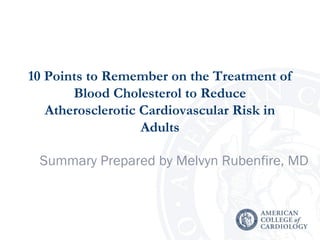
Prevention guidelines cholesterol
- 1. 10 Points to Remember on the Treatment of Blood Cholesterol to Reduce Atherosclerotic Cardiovascular Risk in Adults Summary Prepared by Melvyn Rubenfire, MD
- 2. Point 1 The 2013 ACC/AHA Expert Panel included all 16 members of the National Heart, Lung, and Blood Institute Adult Treatment Panel (ATP) IV, and the document review included 23 expert reviewers and representatives of federal agencies. The expert panel recommendations arose from careful consideration of an extensive body of higher quality evidence derived from randomized controlled trials (RCTs), and systematic reviews and meta-analyses of RCTs.
- 3. Point 2 Through a rigorous process, four groups of individuals were identified for whom an extensive body of RCT evidence demonstrated a reduction in atherosclerotic cardiovascular disease (ASCVD) events (including coronary heart disease [CHD], cardiovascular deaths, and fatal and nonfatal strokes) with a good margin of safety from statin therapy:
- 4. Point 2 (cont.) Four Statin Benefit Groups: •Individuals with clinical ASCVD (acute coronary syndromes, or a history of MI, stable or unstable angina, coronary or other arterial revascularization, stroke, TIA, or peripheral arterial disease presumed to be of atherosclerotic origin ) without New York Heart Association (NYHA) class II-IV heart failure or receiving hemodialysis. •Individuals with primary elevations of low-density lipoprotein cholesterol (LDL-C) ≥190 mg/dl. •Individuals 40-75 years of age with diabetes, and LDL-C 70-189 mg/dl without clinical ASCVD. •Individuals without clinical ASCVD or diabetes, who are 40-75 years of age with LDL-C 70-189 mg/dl, and have an estimated 10-year ASCVD risk of 7.5% or higher.
- 5. Point 3 Individuals in the fourth group can be identified by using the new Pooled Cohort Equations for ASCVD risk prediction, developed by the Risk Assessment Work Group.
- 6. Point 4 Lifestyle modification (i.e., adhering to a heart healthy diet, regular exercise habits, avoidance of tobacco products, and maintenance of a healthy weight) remains a critical component of health promotion and ASCVD risk reduction, both prior to and in concert with the use of cholesterol- lowering drug therapies.
- 7. Point 5 There is no evidence to support continued use of specific LDL- C and/or non–high-density lipoprotein cholesterol (non–HDL- C) treatment targets. The appropriate intensity of statin therapy should be used to reduce risk in those most likely to benefit. Nonstatin therapies, whether alone or in addition to statins, do not provide acceptable ASCVD risk reduction benefits compared to their potential for adverse effects in the routine prevention of ASCVD.
- 8. Point 6 This guideline recommends use of the new Pooled Cohort Equations to estimate 10-year ASCVD risk in both white and black men and women. By more accurately identifying higher risk individuals for statin therapy, the guideline focuses statin therapy on those most likely to benefit. It also indicates, based on RCT data, those high-risk groups that may not benefit.
- 9. Point 7 No recommendations are made to inform treatment decisions in selected individuals who are not included in the four statin benefit groups. In these individuals whose 10-year risk is <7.5% or when the decision is unclear, other factors including family history of premature ASCVD, LDL-C >160 mg/dl, high- sensitivity C-reactive protein ≥2 mg/dl, coronary calcium score ≥300 Agatston units or ≥75th percentile for age, sex, ethnicity, and ankle-brachial index <0.9, or elevated lifetime risk of ASCVD may be used to enhance the treatment decision making.
- 10. Point 8 High-intensity statin therapy is defined as a daily dose that lowers LDL-C by ≥50% and moderate-intensity by 30% to <50%. All patients with ASCVD who are age ≤75 years, as well as patients >75 years, should receive high-intensity statin therapy; or if not a candidate for high-intensity, should receive moderate- intensity statin therapy.
- 11. Point 9 Those with an LDL-C ≥190 mg/dl should receive high-intensity or moderate-intensity statin therapy, if not a candidate for high-intensity statin therapy. Addition of other cholesterol- lowering agents can be considered to further lower LDL-C. Diabetics with a 10-year ASCVD ≥7.5% should receive high- intensity statins and <7.5% moderate-intensity statin therapy. Persons 40-75 years with a ≥7.5% 10-year ASCVD risk should receive moderate- to high-intensity statin therapy.
- 12. Point 10 The following are no longer considered appropriate strategies: treat to target, lower is best. The new GL recommends: treat to level of ASCVD risk, based upon estimated 10- year or lifetime risk of ASCVD. The guidelines provided no recommendations for initiating or discontinuing statins in NYHA class II-IV ischemic systolic heart failure patients or those on maintenance hemodialysis.
- 13. Perspective In primary prevention, the cholesterol guidelines recommend not only the risk calculation, but also the physician–patient review of the risk and the decision to take a statin. It is important to realize that the ASCVD risk calculator is heavily influenced by age. A 65-year-old man and a 71-year-old woman with optimal risk factors have a >7.5% 10-year risk. This is where physician judgment, statin safety issues, and a consideration of patient preferences can inform this decision. Prescription of a statin is not automatic, but part of a comprehensive approach to risk reduction that begins with the use of the ASCVD risk calculator and with the assumption that the physician is addressing each of the modifiable risk factors.
